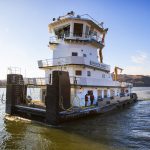Tag Archives: Working Waterfronts
January storms leave many working waterfronts in Maine adrift
 Chris Hole watched in horror last month as the storm pummeled his family’s fishing business at Lookout Point in Harpswell. It was Jan. 13, and the second of two powerful storms in less than a week leveled Henry Allen’s Seafood, a lobster wharf, wholesaler and retailer. Strong winds and high tides wiped out the dock’s seawall, drowned new refrigeration units and flooded buildings with waist-high water. Guy Baker left his fish house on Bailey Island that day so he wouldn’t have to bear witness. When he returned, the building that had stood on the edge of Baker’s family property for more than 80 years had been reduced to a pile of rubble on the shore. Farther up the coast in the Washington County town of Milbridge, all but the supporting structure of Chipman’s Wharf floated away at high tide during the Jan. 10 storm. Photos, more, >>click to read<< 10:11
Chris Hole watched in horror last month as the storm pummeled his family’s fishing business at Lookout Point in Harpswell. It was Jan. 13, and the second of two powerful storms in less than a week leveled Henry Allen’s Seafood, a lobster wharf, wholesaler and retailer. Strong winds and high tides wiped out the dock’s seawall, drowned new refrigeration units and flooded buildings with waist-high water. Guy Baker left his fish house on Bailey Island that day so he wouldn’t have to bear witness. When he returned, the building that had stood on the edge of Baker’s family property for more than 80 years had been reduced to a pile of rubble on the shore. Farther up the coast in the Washington County town of Milbridge, all but the supporting structure of Chipman’s Wharf floated away at high tide during the Jan. 10 storm. Photos, more, >>click to read<< 10:11

Keeping It Working – Maine’s working waterfronts
Maine’s harbors may seem quieter this time of year, but you might be surprised how much activity continues along our working waterfronts in the dead of winter. Marine terminals, ferries, mailboats, and fish-processing plants continue their daily operations. Shipyards are working on repair jobs put off during the busy summer and fall. The hardcore offshore lobstermen are still fishing, while others are rerigging for winter fisheries like scallops, mussels, urchins, and seaweed. Just what constitutes a working waterfront? In Maine, as in the rest of the country, the definition includes all-tide access, so that vessels don’t have to time their arrival and departure schedules strictly around the tide. >click to read< 17:26

The ‘last 20 miles’: Real estate boom, new demands threaten Maine’s working waterfront
Rockland – The potential sale of three commercial waterfront properties has the potential to bring new development and tax revenue, but also great change to the town’s character. The properties are being marketed as development opportunities for hotels, restaurants, retail or office space, residential or marine usage and are listed for sale for $13.9 million, according to the New England Commercial Property Exchange. “We expect that whatever we do will be controversial,” Ed Glaser, mayor of Rockland. Elsewhere in Rockland, the nonprofit Island Institute has been sounding the alarm about shrinking coastal frontage still available for commercial use by fishermen, boatbuilders, marinas and so on. Of Maine’s 5,300 miles of coastline, just a fraction, 20 miles, is still available for working waterfront, according to the nonprofit’s 2014 report, “The Last 20 Miles.” >click to read< 13:32

The Working Waterfront: State may provide grant to Spruce Head Co-op
The Spruce Head Fishermen’s Co-op is in line to get another state grant aimed at preserving working waterfronts. The Land for Maine’s Future Board announced Friday, June 21 in a news release that it has selected six projects that it says will help protect and sustain Maine’s working waterfront.,,, Through the Working Waterfront Access Protection Program, funds have been set-aside to purchase development rights, through a legally binding agreement between the state and working waterfront owners, which will ensure that the property remains available to support commercial fishing or aquaculture activities. The other projects selected by the Board in its June 21 announcement are: >click to read<20:28
Alaska Fish Radio – Connecting Alaskas Communities to Their Working Waterfronts
 I’m Stephanie Mangini. Connecting Alaskas working waterfronts, Farmers began a trend when they started Community Supported Agriculture programs on the East coast. Fishermen quickly caught onto the concept developing their own Community Supported Fisheries . The Alaska Marine Conservation Councils Executive Director Kelly Harrell explains . .listen@fishradio 21:32
I’m Stephanie Mangini. Connecting Alaskas working waterfronts, Farmers began a trend when they started Community Supported Agriculture programs on the East coast. Fishermen quickly caught onto the concept developing their own Community Supported Fisheries . The Alaska Marine Conservation Councils Executive Director Kelly Harrell explains . .listen@fishradio 21:32













































